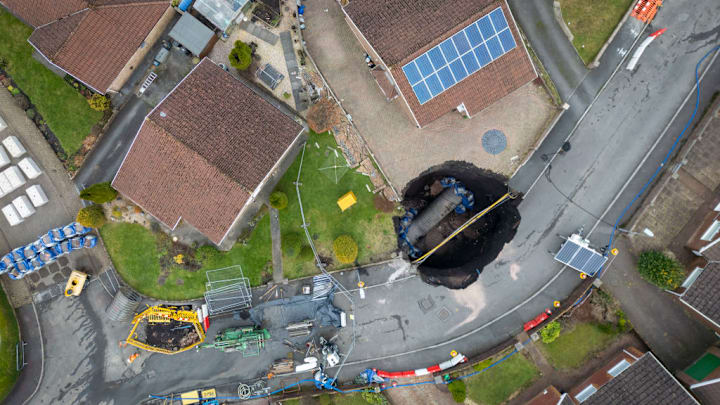Sinkholes have gulped down suburban homes, Corvettes, the White House lawn, a sizable chunk of Louisiana, and even people. The gaping holes are surprisingly common and often appear after the water has altered the underlying bedrock. But how does the ground just open up like that?
Water Has Its Way
Sinkholes are a simple matter of cause and effect. Urban sinkholes may be directly traced to underground water main breaks or collapsed sewer pipelines, into which city sidewalks crumple in the absence of any structural support. In more rural areas, such catastrophes might be attributed to abandoned mine shafts or salt caverns that can't take the weight anymore: A collapsing salt dome created the massive, still-growing Louisiana Sinkhole in the town of Bayou Corne. These types of sinkholes are heavily influenced by human action, but most sinkholes are unpredictable, inevitable natural occurrences.
Florida, which has more sinkholes than any other state, is so prone because the rock underlying its golf courses and amusement parks is limestone—it’s solid rock, but the kind that is easily dissolved by acidic rain or groundwater. When mildly acidic water wears away at fractures in the limestone, it leaves empty space where there used to be stone, resulting in a Swiss cheese-like matrix called karst. Even the residue of the dissolved rock is washed away by rain or flooding. At ground level, soil, grass, or—for example—luxury condominiums perched atop the karst aren't left with much support. Just as a house built on a weak foundation is more likely to collapse, the same is true of the ground itself. Gravity eventually takes its toll, aided by natural erosion, and so the hole begins to sink.
Sinkhole Central
About 10 percent of the world's landscape is composed of karst regions. Along with Florida, U.S. states, including Tennessee, Kentucky, Virginia, and Idaho, are also prime sinkhole territory (plus their large karst areas that have given rise to amazing caves and caverns). Sinkholes’ unpredictable nature serves as proof that the ground beneath our feet may not be as solid as we think.
Discover More Stories About Our Awesome Planet:
A version of this story was published in 2018; it has been updated for 2025.
